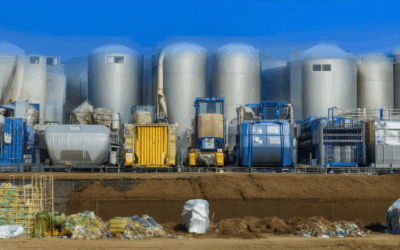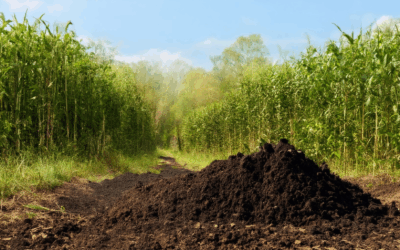Biochar, a versatile and innovative solution, is emerging as a powerful tool in the fight against climate change. Derived from organic materials through controlled pyrolysis, biochar acts as a carbon-rich medium capable of capturing and storing carbon dioxide, thereby reducing greenhouse gas emissions. Its ability to enhance soil health and promote sustainable agriculture has made it a cornerstone of eco-friendly practices across various industries. From agricultural fields to urban settings, biochar is being utilized in innovative ways to mitigate environmental impacts. However, its adoption is not without controversy, as debates surrounding its efficacy, cost-effectiveness, and ethical considerations continue to shape its role in global climate strategies. This article delves into the multifaceted potential of biochar, exploring its benefits, limitations, and the pathways to its widespread implementation.
Key Takeaways
– Can Reduce Greenhouse Gas Emissions: Biochar effectively sequesters carbon dioxide, offering a promising solution for combating climate change.
– Cost-Effective Alternative: Compared to activated carbon, biochar is generally more affordable, especially when sourced from waste materials.
– Improves Soil Health: Applying biochar enhances soil fertility and structure, promoting plant growth and reducing environmental degradation.
– Requires Careful Application: Excess biochar can harm soil health by causing nutrient competition, microbial imbalances, and compaction.
– Sustainable Practice: Biochar production aligns with eco-friendly practices, making it a viable option for environmentally conscious agriculture.

How Does Biochar Reduce Greenhouse Gases?
Biochar plays a significant role in reducing greenhouse gas emissions by acting as a carbon sink and improving soil health. Here’s how it works:
- Carbon Sequestration: Biochar is created by pyrolyzing organic waste, which converts biomass into a stable carbon-rich material. This process traps carbon from organic matter that would otherwise release CO2 during decomposition, effectively removing it from the atmosphere.
- Reduction of Methane Emissions: During the pyrolysis process, methane gas is released as a byproduct. However, biochar production captures and stabilizes this methane, preventing it from contributing to greenhouse gas emissions.
- Improved Soil Health: When biochar is added to soil, it enhances microbial activity and increases the soil’s ability to store carbon. Healthier soils absorb and retain more carbon, reducing the amount of CO2 released into the atmosphere.
- Diverting Organic Waste: By converting organic waste into biochar, we prevent it from decomposing in landfills where it would release methane and CO2. This reduces the environmental impact of waste disposal and diverts materials from traditional waste streams.
- Replacement of Fossil Fuels: In certain applications, biochar can replace fossil fuels in processes like power generation, significantly lowering CO2 emissions associated with energy production.
Biochar’s ability to capture and store carbon makes it a valuable tool in combating climate change. By integrating biochar into sustainable practices, we can contribute to a healthier planet and promote a more circular economy.
Drawbacks of Biochar
- Potential Contamination: Biochar may contain harmful substances such as dioxins, furans, chlorinated hydrocarbons, and polycyclic aromatic hydrocarbons (PAHs). These contaminants can pose serious health risks if ingested or inhaled.
- Environmental Impact: While biochar is often praised for its carbon-sequestration benefits, improper production or application can lead to negative environmental effects. Excessive use might cause drainage issues or disrupt soil health if not managed properly.
- Handling and Disposal Challenges: Biochar can be heavy and difficult to handle, leading to potential messiness during application. Improper disposal can also contribute to environmental contamination.
- Regulatory Gaps: In some regions, the production and sale of biochar may lack sufficient regulation, increasing the risk of distributing contaminated products that could harm users or the environment.

Why is biochar controversial?
The controversy surrounding biochar arises from several interconnected factors, each contributing to the ongoing debates about its viability, benefits, and implementation. Here’s a breakdown of the key reasons:
- Technical Uncertainties :
The production process of biochar, known as pyrolysis, involves high temperatures and specific conditions. While it has shown promise in capturing carbon and improving soil health, there are still questions about its consistency and effectiveness. Concerns about untested technology and potential releases of harmful substances, like PFAS, have raised alarms among some communities. - Environmental Trade-offs :
Although biochar is promoted as an eco-friendly solution, producing it requires significant energy inputs. Critics argue that the energy demands may outweigh the environmental benefits, potentially leading to indirect negative impacts. Additionally, diverting organic waste for biochar production could affect existing markets for compost and animal feed, creating resource allocation conflicts. - Economic Disruptions :
The shift towards biochar production may disrupt traditional agricultural practices. Farmers and industries reliant on conventional methods might face economic pressures as biochar adoption gains traction. There are also concerns about the initial costs of building biochar facilities and the potential exclusion of smaller-scale operators from the market. - Regulatory Challenges :
The lack of standardized regulations for biochar production and use has left room for inconsistency and variability in product quality. Without clear guidelines, consumers and policymakers struggle to assess the reliability and safety of biochar-based solutions, hindering broader adoption. - Public Perception and Skepticism :
New technologies often meet with skepticism, and biochar is no exception. Public distrust stemming from initial reports of unverified claims and potential risks has slowed its acceptance among some communities, despite its potential benefits. - Competitive Alternatives :
Biochar competes with established carbon sequestration methods, challenging existing paradigms. This competition can create tension among stakeholders advocating for different solutions, each vying for recognition as the most effective approach to combating climate change.
In summary, biochar’s controversy reflects a complex interplay of technical, environmental, economic, and social factors. Addressing these challenges requires careful consideration, collaboration among stakeholders, and robust frameworks to ensure biochar’s potential is realized responsibly.

How Much CO2 Does Biochar Remove?
Biochar, a form of charcoal produced through pyrolysis of organic materials, has the potential to sequester a significant amount of carbon dioxide (CO2). Research indicates that biochar can effectively capture and store carbon, contributing to carbon sequestration efforts.
Estimates suggest that biochar soil application could sequester approximately 2.5 gigatons (Gt) of CO2 annually, under ideal conditions and widespread adoption. This figure represents a substantial contribution to global carbon reduction efforts, though actual amounts may vary based on factors such as regional conditions, agricultural practices, and the stability of biochar over time.
It’s important to note that while biochar offers a promising solution for carbon sequestration, its effectiveness can depend on various variables, including its stability and the duration for which it remains effective in different soil types and environments.
Is Biochar Cheaper Than Activated Carbon?
When comparing the cost of biochar versus activated carbon, several factors come into play:
- Economic Performance: According to recent studies, the average cost of producing biochar from date palm waste is approximately $1.06 per kilogram, while activated carbon typically costs around $1.34 per kilogram.
- Raw Material Costs: Biochar is produced from biomass, often waste materials, making it potentially more cost-effective as it utilizes byproducts. In contrast, activated carbon is derived from fossil fuels or petroleum, which can be more expensive raw materials.
- Processing Efficiency: The production method known as pyrolysis for biochar may require specific temperatures and pressures, affecting overall costs. However, this process can sometimes be less resource-intensive than activating charcoal for industrial use.
- Quality and Purity Requirements: High-purity activated carbon may command a premium due to its consistent quality and effectiveness in adsorption processes, whereas biochar may vary in purity depending on the source and processing techniques.
- Sustainability Factors: Biochar production from waste materials aligns with eco-friendly practices, which can influence cost-effectiveness in environmentally conscious markets.
Ultimately, the choice between biochar and activated carbon depends on specific applications, required purity levels, and production scales. Biochar is generally cheaper, but activated carbon may offer better consistency and performance for certain uses.

Can You Add Too Much Biochar to Soil?
Yes, you can add too much biochar to your soil, and doing so may lead to several negative effects. While biochar offers numerous benefits, such as improving soil fertility and reducing greenhouse gas emissions, applying it in excess can be counterproductive.
- Nutrient Competition: Biochar has a high surface area, which allows it to attract and hold onto nutrients. Excessive biochar can cause nutrient competition, meaning plants may struggle to access essential nutrients needed for growth.
- Microbial Activity: Biochar can influence microbial activity in the soil. An overabundance of biochar might hinder the breakdown of organic matter by microbes, potentially reducing the availability of nutrients over time.
- Compaction: Adding too much biochar can lead to soil compaction. This makes it harder for water and air to penetrate the soil, which is crucial for plant root health and overall soil functionality.
- pH Alteration: Biochar can affect soil pH levels. Depending on the specific needs of your plants, an imbalance in pH can negatively impact crop growth and yield.
For optimal results, it’s recommended to apply biochar at a rate of approximately 5% by volume. Exceeding this amount may lead to the aforementioned issues. Always test your soil before applying biochar and consider the specific needs of your plants to avoid unintended consequences.




0 Comments